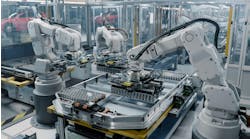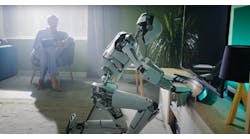In case you’ve somehow missed it, robots are everywhere. “There were 85 robots at the PyeongChang Winter Olympics,” said Mark Duncan, material handling/logistics segment manager at Schneider Electric. “Robots are becoming more and more prevalent. Robots have never been more performant and more affordable, and the integration of robots has never been easier.”
Duncan was just one of many presenters at the Schneider Electric Industry Innovation Summit in Schaumburg, Illinois. As sensors and vision systems have come down in costs, robotics are being deployed more, he explained. “Companies and countries have seen the advantages of robotics. We’ll see 1.7 million new industrial robots by 2020, according to the International Federation of Robotics, and not just in the automotive industry, but in food and beverage and material handling,” he said.
2017 was a milestone year for the North American robotics market as it surpassed previous records in all four statistical categories: order units, order revenue, shipment units and shipment revenue. “What I find most telling about these results is not simply that the automation market continues to grow, but that it is growing in such a wide variety of industries," agrees Jeff Burnstein, president of the Association for Advancing Automation (A3). "New industries continue to embrace robotics, vision and motion, reaping the benefits of automation."
The number of robots sold in North America last year surpassed all previous records. Customers purchased almost 35,000 total units representing just short of $2 billion in total sales, which is annual growth of 0.9% and 0.1%, respectively. While automotive-related orders were down, non-automotive orders fueled the rise in 2017 with 20.5% growth in units and 7.3% in dollars.
2017 shipments increased 30% in units and 20% in dollars from 2016 results. The largest growth rates for units shipped came from the plastics and rubber (60%), metals (54%), and food and consumer goods (44%). Automotive shipments were flat in both units and dollars compared to 2016.
More imaging components and systems were sold than ever before last year as demand for machine-vision solutions reached record levels in North America. In 2017, total machine-vision financial transactions for both system and component markets in North America grew 15% over 2016 to $2.633 billion. In 2017, total system markets increased 15% to $2.262 billion, while total component markets grew 12% to $359 million.
“We’re seeing the market change. Robots are more diversified, and applications of robots are more diversified,” said Duncan. “Robots are a key component of the Internet of Things. In the past, we’ve seen robots with proprietary control that you had to integrate. Today we’re seeing robots that can be controlled by nonproprietary control concepts, complex functions integrated into IEC 61131-3-compliant modules.
“Machine builders need to innovate more than ever,” said Duncan. “They need to use the digital technologies that are available. Smart machines are connected, flexible, safe and secure.”






